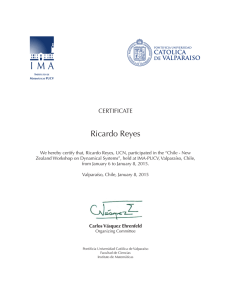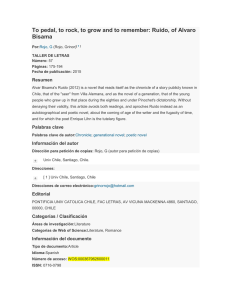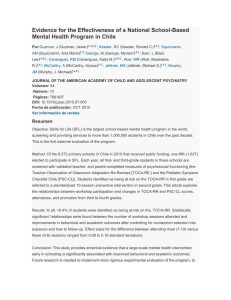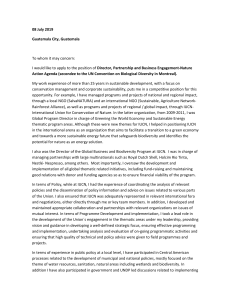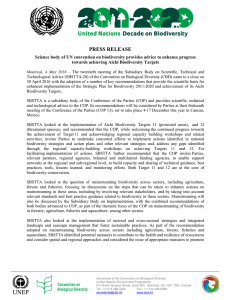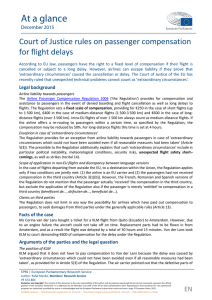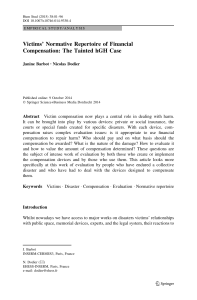Presentation
Anuncio
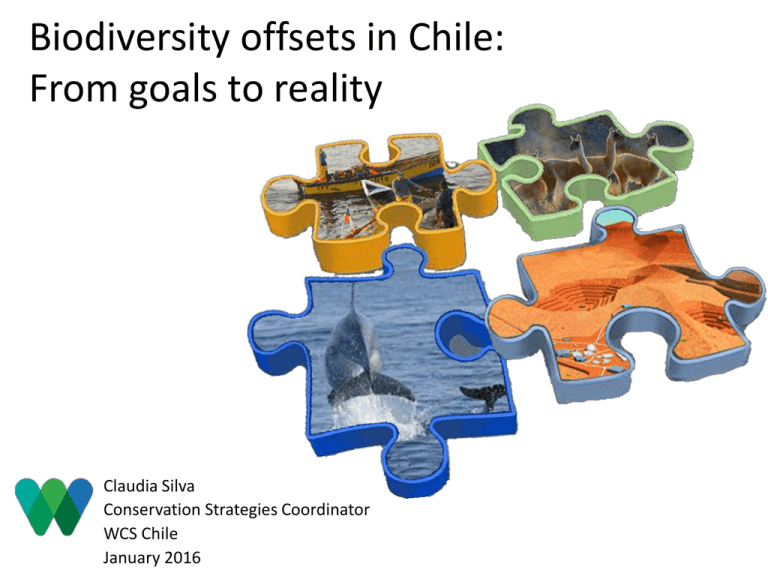
Biodiversity offsets in Chile: From goals to reality Claudia Silva Conservation Strategies Coordinator WCS Chile January 2016 WCS saves wildlife and wild places worldwide through science, conservation action, education, and inspiring people to value nature www.wcs.org Evolution in managing impacts on biodiversity No Some compensation compensation • Out of kind • Little relationship between loss and gain Offset • Mitigation hierarchy • Equivalence between impacts and gains Offset Scheme • Coordinator agency • E.g. aggregated offsets • Implementation by certified thirdparty Evolution of managing impacts on biodiversity: Chile 2nd period 1st period 2008: Regulatory requirement to reforest trees 1997: Regulatory requirement to compensate 2012-2013: Design of a compensation system for mining sector in Tarapacá 2014: Regulatory requirement to offset 2014: Guidelines for biodiversity offsetting within EIA 2014: Mining sector adopts No Net Loss Goal 3rd period 2015: Energy sector adopts No net Loss Goal 2015: Proposal of metric for forests 2015: Proposal of metric for marine habitats 1st period: “Trial and error” • Law 19.300 (1994): EIA required for certain industries/activities with significant impacts on natural resources or protected areas/environmental value of the territory. Approval of EIA requires appropriate mitigation, reparation and compensation measures. • EIA system regulation (1997): 1997: Regulatory requirement to compensate Natural resources includes biological diversity and its regeneration capacity Mitigation = avoidance or minimization 1st period: “Trial and error” • EIA system regulation (1997): Compensation measures have as purpose to produce a positive and equivalent effect alternative to a identified negative effect. No Net Loss? 1997: Regulatory requirement to compensate But… No hierarchical relationship established between measures. Compensation needs to take place on impact site. 1st period: “Trial and error” Diagnosis after 15 years: Loose use of mitigation and compensation concepts • Loopholes allow to skip EIA • Little or no avoidance • Focus of actions on rescue and relocation and reforestation • Compensation unrelated to impacts (qualitatively or quantitavely) • Most frequent compensation measure: monitoring 1997: Regulatory requirement to compensate • Little enforcement or follow-up Bovarnick et al. 2010, Guijón &Püschel 2012, Fundación Chile 2013 1st period: “Trial and error” Results: Bd compensations turned into social subsidies Expensive and ineffective measures Companies bound to unfeasible measures “carved in stone” Companies being fined for breach 1997: Regulatory requirement to compensate Failure in complying with regulation, means increased risk for business activity and failure to conserve national biodiversity 2nd period: Big goals 2008: Regulatory requirement to reforest trees 2012-2013: Design of a compensation system for mining sector in Tarapacá 2014: Regulatory requirement to offset 2014: Guidelines for biodiversity offsetting within EIA 2014: Mining sector adopts No Net Loss Goal 2015: Energy sector adopts No net Loss Goal 2nd period: Big goals Native Forest Law (2008): Requirement to reforest trees Design of method for offsetting biodiversity in the mining sector FChile (2012-2013): Lack of sistematized biodiversity data Lack of ecosystem approach in EIA Training needed by EIA consultants, reviewers and civil society First Guide for biodiversity offsetting 2nd period: Big goals New regulation for EIA system (2014): Introduces hierarchy: compensation applies only to impacts that can’t be mitigated or restored. Compensation measures may take place outside site of impact Guidelines for biodiversity compensation within EIA (2014): Defines “appropriate” compensation as offset -Mitigation hierarchy -No net loss as goal -Equivalence in type and magnitude of losses and gains 2nd period: Big goals Presidential Comission on the future of Mining (2014): Adopts No Net Loss as goal for 2035 Road Map for energy sector for 2050 (2015): Adopts No Net Loss of as a goal for 2035 Some compensation 2nd period: Big goals Conservation of biodiversity Companies and consultants State agencies Offsets 3rd period: getting real GOAL Biodiversity offsetting scheme that is: - Integrated and coordinated - Effective for conservation and compliance - Cost-efficient 3rd period: getting real • Improve biodiversity data • Refine guidelines (metrics, pilots) • Training and outreach across sectors • Develop tools and capacity for coordinated efforts 3rd period: getting real Some steps forward: MMA/UNDP • Proposal of metric for mediterranean forests (Magni et al. 2015) • Proposal of metric for marine habitats (Gelcich et al. 2015) MMA • Working on classification of terrestrial, freshwater and marine ecosystems MMA/WCS • Pilot application of offsets Oportunities & Challenges GOVERNMENT is introducing offset policies and working in tools for implemetantion COMPANIES are implementing internal No Net Loss policies and figuring out how to comply with regulation PRIVATE CONSERVATION Initiatives are in desperate need for funding for active conservation CIVIL SOCIETY is demanding best practice in biodiversity management and will want to have a saying Oportunities & Challenges COMPANIES are implementing internal No Net Loss policies and figuring out how to comply with regulation GOVERNMENT is introducing offset policies and working in implemetantion tools Harmonization PRIVATE CONSERVATION Initiatives are in desperate need for funding for active conservation CIVIL SOCIETY is demanding best practice in biodiversity management References & bibliography Bovarnick A, Knight C & Stephenson J (2010) Habitat Banking in Chile: A Feasibility Assessment Working Paper. United Nations Development Programme, 2010. Comisión Minería y Desarrollo de Chile (2014). Minería: una plataforma de futuro para Chile. Informe a la Presidenta de la República, Michelle Bachelet. Consejo Nacional de Innovación y Competitividad. 78pp. Disponible en www.valorminero.cl Comité Consultivo de Energía (2015). Hoja de ruta 2050 Hacia una energía sustentable e inclusiva para Chile. Ministerio de Energía. 204 pp. Disponible en www.energia2050.cl EIA System regulation and guidelines: www.sea.gob.cl Fundación Chile (2013) Evolución histórica de las medidas de Compensación en biodiversidad del Cluster minero en Chile. Informe proyecto FIC-GORE “Perfeccionamiento del mercado y desarrollo de la oferta de servicios especializados en compensaciones de biodiversidad de la región de Tarapacá para el cluster minero. Fundación Chile. 39 pp. Gelcich S, Donlan J, Mansur L, Vargas L & Castilla JC (2015). Propuesta de protocolo de creditización para la creación de esquemas de compensación en biodiversidad en la zona costera de Chile central” Informe Final para Programa de Naciones Unidas para el Desarrollo y Ministerio del Medio Ambiente. 41 pp.+anexos. Magni C, Scherson R, Romero F & Martínez E (2015) Propuesta de protocolo para la definición de créditos por ganancias en biodiversidad en ecosistemas mediterráneos de Chile central. Informe Final para Programa de Naciones Unidas para el Desarrollo y Ministerio del Medio Ambiente. 123 pp. Püschel L, & Guijón R (2012) Compensación en biodiversidad en el Sistema de Evaluación de Impacto Ambiental. In S. Montenegro et al., eds. Actas de las VI Jornadas de Derecho Ambiental. Abeledo Perrot Chile / Universidad de Chile, p. 18. Gracias




